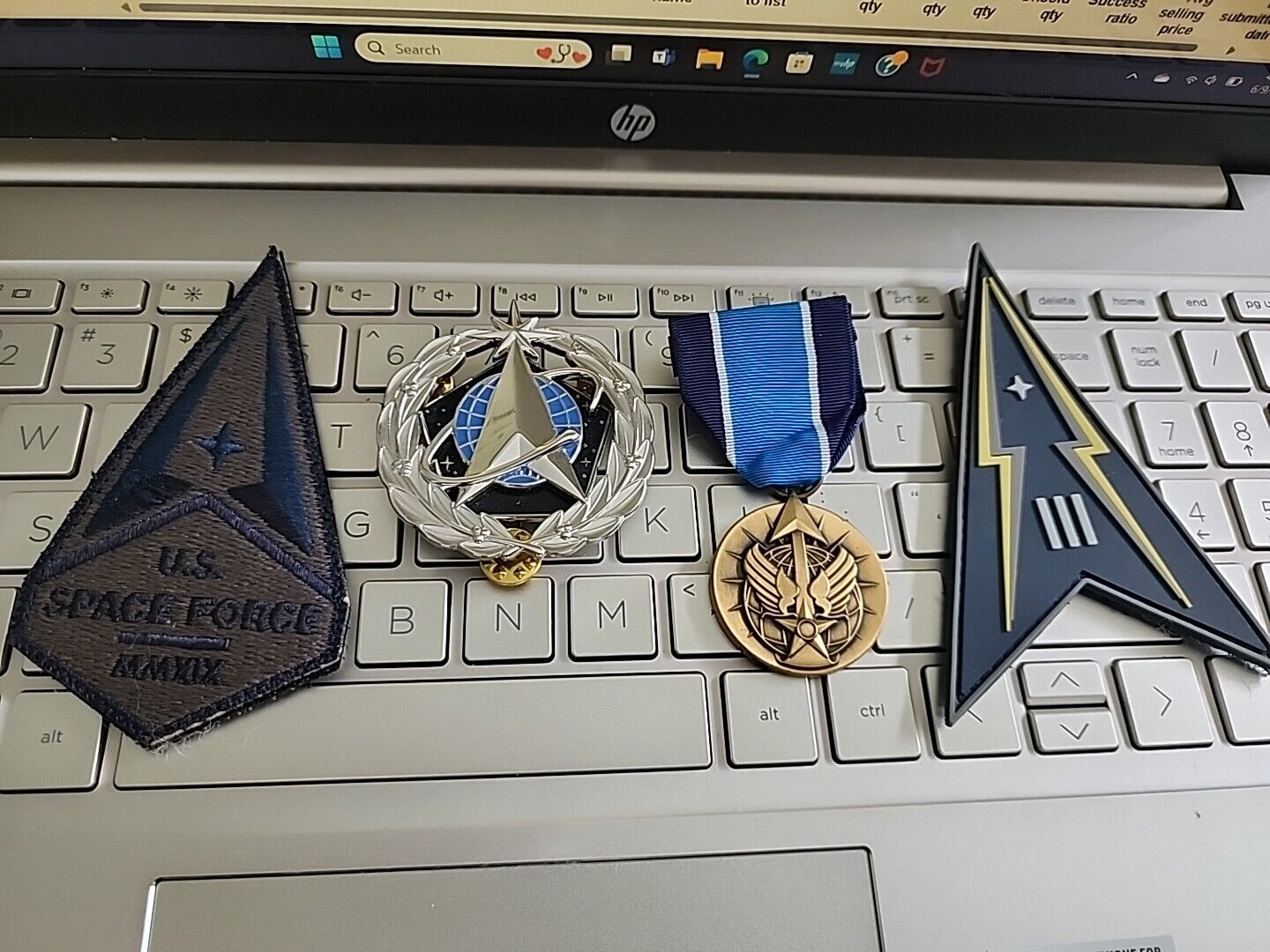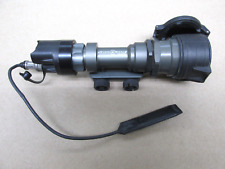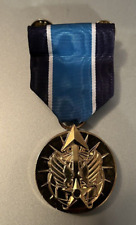Remote Combat Effects Campaign Medal Space Force Badge+ 2- Patches SEE STORE For Sale

When you click on links to various merchants on this site and make a purchase, this can result in this site earning a commission. Affiliate programs and affiliations include, but are not limited to, the eBay Partner Network.
Remote Combat Effects Campaign Medal Space Force Badge+ 2- Patches SEE STORE:
$69.99
PLEASE FOLLOW OUR E BAY STORESEE ALL PICSSALE SEE OUR STOREPLEASE READ WHOLE ADDPLEASE SEE STORELOT MORE --COMBINE SHIPPINGSAVE $$$$$$$$$$$$$$$Remote Combat Effects Campaign Medal1 language
- Article
- Talk
- Read
- Edit
- View history
Campaign MedalObverseTypeService medalAwarded forParticipating in a combat operation from a remote location in a non-deployed status on or after September 11, 2001Presented bytheU.S. Department of the Air Force[1]EligibilityU.S. Air Force and U.S. Space Force personnelStatusCurrently awardedEstablished22 May 2019First awarded2019 (retroactive to September 11, 2001)Service ribbon of the medalPrecedenceNext(higher)Military Outstanding Volunteer Service Medal[2]Next(lower)Air and Space Campaign Medal[3]
TheRemote Combat Effects Campaign Medal(RCECM) is aUnited States Air ForceandUnited States Space Forcecampaign medal established on 22 May 2019. The medal recognizes air force personnel, "in non-deployed status who directly participated in aU.S. Department of Defense(DoD) combat operation from a remote location.[4]
Eligibility[edit]The RCECM will be awarded toairmenand guardians serving in remotely piloted aircraft, cyber, space and intelligence, surveillance and reconnaissance career fields, who create direct combat effects from remote locations and lead to strategic outcomes or the delivery of lethal force. In some circumstances, airmen and guardians from other career fields may be considered for the RCECM, which will be considered on a case-by-case basis.
Service members may be awarded the RCECM for actions completed on or after11 September 2001, while also serving under the following conditions:
- Was assigned or attached to a unit directly in support of a DoD combat operation as approved by the chief of staff of the Air Force (listed below)
- Was serving in a remotely piloted aircraft; cyber; space or intelligence, surveillance and reconnaissance career field
- Personally provided hands-on employment of a weapon system that had direct and immediate impact on combat operations
- Was not physically exposed to hostile actions or at risk of exposure to hostile action
Qualifying DoD combat operations:
OperationFromToEnduring Freedom(OEF)[5]11 September 200128 December 2014[6]Iraqi Freedom(OIF)[5]19 March 200331 August 2010Nomad Shadow(ONS)[5]5 November 2007TBDNew Dawn(OND)[5]1 September 201031 December 2011Inherent Resolve(OIR)[5]15 June 201430 March 2016Freedom's Sentinel(OFS)[5]1 January 201531 August 2021Odyssey Lightning(OOL)[5]1 August 201619 December 2016Operation Pacific Eagle (OPE–P)[5]5 October 2017TBDEligible personnel will be only awarded one medal upon meeting the initial criteria for the award. A separate bronzecampaign staris worn on the medal suspension or ribbon to recognize each qualifying DoD combat operation in which the personnel participated for one or more days.
Description[edit]The medal bears a bronze color 1 ¼ inch metal disc bearing a starburst. The starburst behind the grid-lined sphere conveys power and the ability to remotely effect the battlefield, anywhere in the world. The delta followed by the contrail portrays the remotely piloted aircraft and weapons systems. TheHap Arnoldsymbol denotes the U.S. Air Force. The reverse bears a circular inscription, “COMBAT EFFECTS CAMPAIGN” above, and “UNITED STATES AIR FORCE” below, and a “Hap Arnold” symbol above a stacked inscription that reads “REMOTE COMBAT SUPPORT”. A pair of beveled deltas flank the circular inscription.
The ribbon is predominantly blue, with a wide light blue center stripe flanked on either side by a narrow white stripe. The colors represent the U.S. Air Force.
United States Space Force44 languages- Article
- Talk
- Read
- Edit
- View history
Space Force DeltaFounded20December 2019; 4 years agoCountryUnited StatesTypeSpace forceSize
- 8,600 military personnel[1][2]
- 77 spacecraft[3]
Department of the Air ForceHeadquartersThe Pentagon
Arlington County, Virginia, U.S.[4]Motto(s)
- Semper Supra
- "Always above"[5]
As U.S. Space Force
- Global War on Terrorism
- Afghanistan Campaign
- Inherent Resolve Campaign[7]
- [link removed by ]
- [link removed by offerenSecretary of DefenseLloyd AustinSecretary of the Air ForceFrank Kendall IIIChief of Space OperationsGenB. Chance SaltzmanVice Chief of Space OperationsGenMichael GuetleinChief Master Sergeant of the Space ForceCMSSFJohn F. BentivegnaInsigniaFlagSealDelta, Globe, and OrbitLogoUnited States
Armed ForcesExecutive departments- Department of Defense
- Department of Homeland Security
- Office of the Secretary of Defense
- Joint Chiefs of Staff
- Department of the Army
- Department of the Navy
- Department of the Air Force
- United States Army
- United States Marine Corps
- United States Navy
- United States Air Force
- United States Space Force
- United States Coast Guard
- v
- t
- e
TheUnited States Space Force(USSF) is thespace service branchof theUnited States Armed Forces. Along with the Air Force, it is part of theDepartment of the Air Force, led by thesecretary of the Air Force.[8]Its military heads are thechief of space operations, who is one of theJoint Chiefs of Staff, and thevice chief of space operations.
The Space Force is the smallest U.S. armed service, consisting of 8,600 military personnel.[1]It operates 77 spacecraft in total across various programs such asGPS,Space Fence, military satellite communications constellations,X-37Bspaceplanes,U.S. missile warning system,U.S. space surveillance network, and theSatellite Control Network. Under theGoldwater–Nichols Act, the Space Force is responsible for organizing, training, and equipping space forces, which are then presented to theunified combatant commands, predominantly toUnited States Space Command, for operational employment.
The U.S. Space Force traces its roots to the beginning of theCold War, with the first military space programs starting in 1945. In 1954, the Air Force established the Western Development Division, the world's first dedicated space organization, under GeneralBernard Schrieverand unified its space forces under Air Force Space Command in 1982. U.S. space forces have participated in every U.S. conflict since theVietnam War, most notably in thePersian Gulf War, often referred to as the first "space war".
The first discussion of a U.S. Space Force occurred under PresidentDwight Eisenhower's administration in 1958 and it was nearly established in 1982 by PresidentRonald Reaganas part of theStrategic Defense Initiative. The 2001 Space Commission argued for the creation of a Space Corps around 2007–2011, but due to theSeptember 11 attacksandwar on terrorany plans were put on hold. In 2017, RepresentativesJim CooperandMike Rogers' proposal for a Space Corps passed the House but failed in the Senate. In 2019, the House and Senate resolved their differences to pass the United States Space Force Act. It was signed into law by PresidentDonald Trump, establishing the U.S. Space Force as the first new independent military service since the Army Air Forces were reorganized as the U.S. Air Force in 1947.[9]
Mission[edit]As outlined in10U.S.C.§9081and originally introduced in theUnited States Space Force Act, the Space Force is organized, trained, and equipped to:
- Provide freedom of operation for the United States in, from, and to space;
- Conduct space operations; and
- Protect the interests of the United States in space.
TheDepartment of Defensefurther defines the specified functions of the Space Force to:[10]
- Provide freedom of operation for the United States in, from, and to space.
- Provide prompt and sustained space operations.
- Protect the interests of the United States in space.
- Deter aggression in, from, and to space.
- Conduct space operations.
On 10 August 2020, the Space Force released its capstone doctrine,Spacepower: Doctrine for Space Forces, further expanding on its enumerated missions and duties. InSpacepower, the Space Force defines its three cornerstone responsibilities of military space forces, which it articulates why spacepower is vital to U.S. prosperity and security.[11]
- Preserve freedom of action: Unfettered access to and freedom to operate in space is a vital national interest; it is the ability to accomplish all four components ofnational power– diplomatic, information, military, and economic – of a nation's implicit or explicit space strategy. Military space forces fundamentally exist to protect, defend, and preserve this freedom of action.
- Enable Joint Lethality and Effectiveness: Space capabilities strengthen operations in the other domains of warfare and reinforce every Joint function – the US does not project or employ power without space. At the same time, military space forces must rely on military operations in the other domains to protect and defend space freedom of action. Military space forces operate as part of the closely integrated Joint Force across the entire conflict continuum in support of the full range of military operations.
- Provide Independent Options: A central tenet of military spacepower is the ability to independently achieve strategic effects. In this capacity, military spacepower is more than an adjunct tolandpower,seapower,airpower, andcyberpower. Across the conflict continuum, military spacepower provides national leadership with independent military options that advance the nation's prosperity and security. Military space forces achieve national objectives by projecting power in, from, and to space.
The cornerstone responsibilities are executed through the five military spacepower core competencies:[11]
- Space Security: establishes and promotes stable conditions for the safe and secure access to space activities for civil,commercial, intelligence community, and multinational partners.
- Combat Power Projection: integrates defensive and offensive operations to maintain a desired level of freedom of action relative to an adversary. Combat Power Projection in concert with other competencies enhances freedom of action by deterring aggression or compelling an adversary to change behavior.
- Space Mobility and Logistics (SML): enables movement and support of military equipment and personnel in the space domain, from the space domain back to Earth, and to the space domain.
- Information Mobility: provides timely, rapid and reliable collection and transportation of data across the range of military operations in support of tactical, operational, and strategic decision making.
- Space Domain Awareness(SDA) encompasses the effective identification, characterization and understanding of any factor associated with the space domain that could affect space operations and thereby impact the security, safety, economy, or environment of our Nation.
Following the end of theWorld War II, each of the military services began to turn to space.General of the ArmyHenry H. Arnold, commander of theArmy Air Forcesidentified spaceflight as a critical military capability, with each of the services developing parallel space and rocket programs.[12]
In 1954 the Air Force created the first dedicated space organization in the world, creating theWestern Development Divisionunder GeneralBernard Schriever.[13][14]The Army followed shortly after, establishing theArmy Ballistic Missile Agencyin 1955, led by GeneralJohn Bruce Medarisand former German scientistWernher von Braun. Both these organizations, along with theNaval Research Laboratory, were vital in developing the first American rockets and spacecraft.[15]
The launch ofSputnik 1and the initial failure of the Naval Research Laboratory'sProject Vanguardreinvigorated the military space program, with the Army successfully launching America's first satellite,Explorer 1on aJuno 1rocket. Sputnik also prompted a short-lived consolidation of military space under theAdvanced Research Projects Agency. Despite concerns within the existing military services that the Advanced Research Project Agency would evolve into a U.S. Space Force, space authorities were returned to the Army, Navy, and Air Forces.[16]
However, the newly establishedNational Aeronautics and Space Administrationabsorbed the Army Ballistic Missile Agency and the Navy's Project Vanguard in 1959, leaving the Air Force mostly unscathed. In 1961, the Air Force was designated the military's executive agent for space, giving it leadership within the Department of Defense.[16]
Military space operations in the Cold War[edit]Based on theGemini spacecraft, theManned Orbiting Laboratorywas intended to serve as an orbital reconnaissance spacecraftWhile the Air Force had overall leadership in space, the Army and Navy still had space missions, with the Army and Navy responsible for operating elements ofsatellite communicationssystems and the Navy leading the development and operation ofsatellite navigationsystems. Established in 1962 as the world's first military space operations command, theNavy Astronautics Groupwas created to operate the Navy's communication and navigation satellites.[17]The first military employment of space forces occurred during theVietnam War, with the Air Force using its weather and communications satellites to support ground and air operations in theater. Early military spacecraft included the Air Force'sDefense Satellite Communications System,Velanuclear detonation detection satellites, theMissile Defense Alarm System, and the Navy'sTransitandTimationnavigation satellites[16]Presidents Eisenhower and Kennedy were strong advocates of the United States' space programs – both military and civil. During President Kennedy'sWe choose to go to the Moonspeech, he declared:
Space science, like nuclear science and all technology, has no conscience of its own. Whether it will become a force for good or ill depends on man. And only if the United States occupies a position of preeminence can we help decide whether this new ocean will be a sea of peace or a new terrifying theatre of war. I do not say that we should or will go unprotected against the hostile misuse of space, any more than we go unprotected against the hostile use of land or sea.[18]
TheX-20 Dyna Soarwas intended to be the Air Force's first spaceplaneEach of the military services also provided significant support to NASA's civil space program, with the Army Ballistic Missile Agency's Project Adam and Air Force'sMan in Space Soonestprograms forming the basis for NASA'sProject Mercury. The Army and Air Force developed all of NASA's pre-Saturn V space launch vehicles, with the Army Ballistic Missile Agency designing theRedstoneandSaturn I, while the Air Force repurposed theAtlas.[19]The Air Force, Marine Corps, and Navy provided all of NASA's early astronauts and led astronaut rescue and recovery missions. The Air Force also provided range support for NASA launches fromCape Canaveral Space Force Station.[16]
Concerned by Soviet orbital flights, the Air Force strongly pushed for a crewed military spaceflight program. GeneralCurtis LeMaydrew parallels between space operations in the 1960s and air operations inWorld War I, describing how airplanes quickly evolved from peaceful chivalric, unarmed reconnaissance flights to combat efforts designed to destroy enemy air superiority and that it would be naive to believe that the same trends were not expected to be seen and prepared for in space. Although the Air Force made significant progress towards the development of theBoeing X-20 Dyna-Soarspaceplane,Manned Orbiting Laboratory, andBlue Gemini, ultimately political opposition from the Department of Defense prevented them from being operationally fielded.[16]
Cobra Daneradar atEareckson Air Station, Alaska
he major Space Forces, and the fictional Starfleet emblem

Related Items:Nice SUREFIRE M951 Combat Rifle Flashlight w/ Remote Switch / Mount / IR Filter
$159.99
Remote Combat Effects Campaign Medal Space Force Badge+ 2- Patches SEE STORE
$59.99
United States Air Force Medal: Remote Combat Support Medal (Combat Effects)
$44.00



